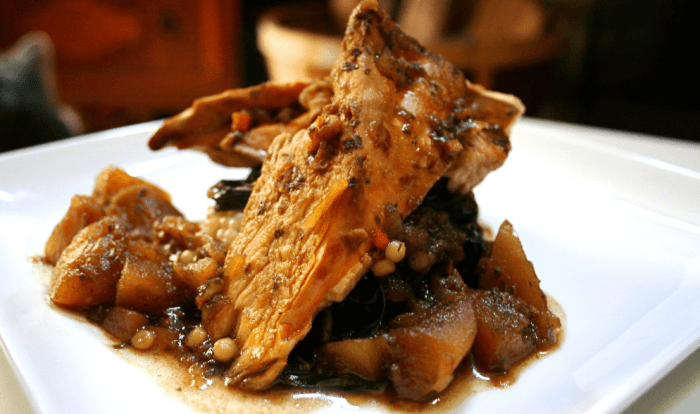
Get ready to embark on a culinary adventure with the chicken of the woods recipe! This wild mushroom is not only delicious but also incredibly versatile, offering a range of culinary possibilities that will tantalize your taste buds.
From hearty soups and stews to sizzling stir-fries and grilled delights, the chicken of the woods shines in every dish. Its unique flavor and texture will add a touch of the wild to your meals, making them unforgettable.
Chicken of the Woods Identification
Chicken of the woods is a widely distributed mushroom that is highly prized for its delicious flavor and meaty texture. It is characterized by its bright orange to yellow coloration, which makes it easily recognizable in the wild.
Chicken of the woods grows in clusters on the trunks of dead or dying hardwood trees, particularly oak, maple, and beech. It typically appears in late summer to early fall and can reach impressive sizes, with some specimens weighing up to several pounds.
Distinguishing Chicken of the Woods from Similar Mushrooms
While chicken of the woods is generally easy to identify, it is important to be able to distinguish it from similar-looking mushrooms to avoid any potential health risks.
- Laetiporus sulphureus:This mushroom is also known as the sulfur shelf and has a similar appearance to chicken of the woods. However, it is typically brighter yellow in color and has a more sulfurous odor.
- Polyporus squamosus:This mushroom, also known as the scaly polypore, has a brownish-orange cap with large, scaly plates. It is typically found on the ground rather than on trees.
- Fistulina hepatica:This mushroom, known as beefsteak fungus, has a deep red to brownish-red cap and a meaty texture. It is typically found on oak trees.
If you are unsure about the identity of a mushroom, it is always best to consult with an expert before consuming it.
Culinary Applications

Chicken of the woods is a versatile culinary delight that can be incorporated into a wide range of dishes. Its meaty texture and savory flavor make it an excellent substitute for chicken in many recipes.
Here are a few culinary applications that showcase the versatility of chicken of the woods:
Soups and Stews
- Chicken of the woods can be added to soups and stews for a hearty and flavorful addition. Its meaty texture and savory flavor complement the other ingredients in the dish.
- Try simmering chicken of the woods in a creamy mushroom soup or a hearty vegetable stew for a comforting and satisfying meal.
Stir-Fries
- Chicken of the woods can be stir-fried with other vegetables and sauces for a quick and easy meal. Its meaty texture holds up well to stir-frying and it absorbs the flavors of the sauce.
- Try stir-frying chicken of the woods with broccoli, carrots, and a savory teriyaki sauce.
Grilled Dishes
- Chicken of the woods can be grilled over medium heat until it is tender and slightly charred. The grilling process enhances its savory flavor and gives it a smoky aroma.
- Try grilling chicken of the woods with vegetables such as bell peppers, onions, and zucchini for a flavorful and healthy summer meal.
Nutritional Benefits
Chicken of the woods is not just a delicious mushroom; it’s also packed with nutritional value. It’s an excellent source of protein, providing a substantial amount per serving. Protein is essential for building and repairing tissues, making it a crucial nutrient for overall health and well-being.
In addition to protein, chicken of the woods is rich in fiber. Fiber is important for digestive health, as it helps regulate bowel movements and promotes a healthy digestive system. It also helps keep you feeling full and satisfied, which can aid in weight management.
Antioxidants
Chicken of the woods is also a good source of antioxidants. Antioxidants are compounds that help protect your cells from damage caused by free radicals. Free radicals are unstable molecules that can damage cells and contribute to aging and chronic diseases.
The antioxidants in chicken of the woods help neutralize free radicals, protecting your cells and potentially reducing your risk of developing certain health conditions.
Preservation Techniques

Preserving chicken of the woods is crucial to extend its shelf life and enjoy its unique flavor beyond its fresh state. Various methods exist, each with its advantages and steps to follow.
Craving a delicious, meaty meal? Look no further than the chicken of the woods recipe . This edible mushroom has a texture and flavor similar to chicken, making it a perfect plant-based alternative. Whether you’re a seasoned forager or just starting out, this recipe will guide you through the process of preparing and cooking this tasty treat.
Drying
Drying is a traditional preservation technique that removes moisture from the mushroom, inhibiting spoilage.
-*Steps
I’m not sure what you’re looking for when you say “chicken of the woods recipe.” Are you looking for a recipe for a specific dish? If so, I would recommend checking out the chicken of the woods recipe that I found online.
It looks pretty delicious, and it’s got a lot of great reviews.
Slice the chicken of the woods thinly.
Arrange the slices on a drying rack or in a dehydrator.
Dry at a temperature between 110-130°F (43-54°C) for several hours, or until completely dry.
Store the dried mushrooms in an airtight container in a cool, dry place.
Freezing
Freezing is a convenient method to preserve chicken of the woods for extended periods.
-*Steps
Clean and slice the chicken of the woods.
Blanch the slices in boiling water for 2-3 minutes.
If you’re looking for more general information about chicken of the woods, I would recommend checking out the chicken of the woods recipe that I found online. It’s got a lot of great information about the mushroom, including how to identify it, where to find it, and how to cook it.
Drain and cool the slices.
Place the slices in freezer-safe bags or containers.
Freeze at 0°F (-18°C) or below for up to 6 months.
Pickling
Pickling involves preserving the chicken of the woods in a vinegar solution.
-*Steps
Clean and slice the chicken of the woods.
Prepare a pickling solution by combining equal parts vinegar and water, along with spices and herbs of your choice.
Place the mushroom slices in a jar or container.
Pour the pickling solution over the mushrooms, ensuring they are fully submerged.
Seal the container and store in a cool, dark place for at least 2 weeks before consuming.
Cultivation and Foraging
Chicken of the woods can be cultivated at home, though it requires a specific growth medium and controlled conditions. The process involves inoculating logs or sawdust with mushroom spawn and providing optimal moisture and temperature for growth.
Foraging for chicken of the woods in the wild requires knowledge of its habitat and identification characteristics. Safety precautions include wearing gloves to avoid skin irritation and cooking the mushrooms thoroughly to destroy any potential toxins.
Cultivation
- Inoculate logs or sawdust with chicken of the woods spawn.
- Maintain moisture levels and temperatures between 55-65°F (13-18°C).
- Provide indirect sunlight or artificial lighting.
- Monitor growth and harvest when the mushroom reaches maturity.
Foraging, Chicken of the woods recipe
- Identify chicken of the woods by its orange-yellow color, wavy edges, and chicken-like texture.
- Wear gloves to prevent skin irritation from its trichomes.
- Cook the mushrooms thoroughly to eliminate any potential toxins.
- Avoid foraging in areas with heavy pesticide or herbicide use.
Conclusion: Chicken Of The Woods Recipe

As we conclude our exploration of the chicken of the woods recipe, we hope you’re inspired to experiment with this culinary gem. Whether you’re a seasoned chef or a novice cook, the chicken of the woods is sure to become a favorite ingredient in your kitchen.
So gather your ingredients, fire up the stove, and let the flavors of the forest dance on your palate. Happy cooking!
FAQ Summary
Can I eat chicken of the woods raw?
No, it’s not recommended to eat chicken of the woods raw. Cooking helps to release its full flavor and make it safe to consume.
How can I store chicken of the woods?
Store chicken of the woods in a paper bag or container in the refrigerator for up to 5 days. You can also freeze it for longer storage.
What are the nutritional benefits of chicken of the woods?
Chicken of the woods is a good source of protein, fiber, and antioxidants. It’s also low in calories and fat.





